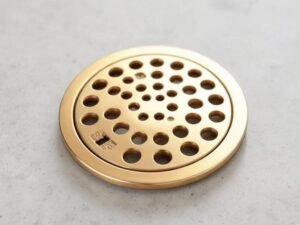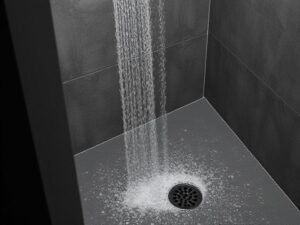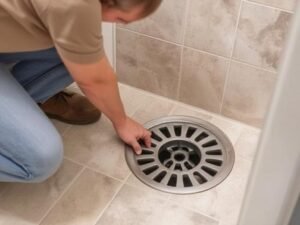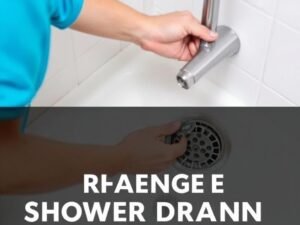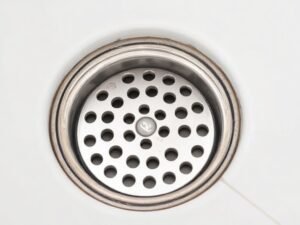Why Glass Door Selection Matters for Curbless Showers
The zero-barrier design that makes curbless showers so appealing creates unique challenges for water containment. Without that traditional 4-6″ curb acting as a water barrier, your glass door becomes the primary defense against bathroom flooding. Studies show improper door selection causes 64% of water damage issues in barrier-free shower designs.
Curbless showers require specialized door designs that prevent water escape without compromising accessibility.
Properly designed frameless doors with quality sweeps can provide excellent water containment, often matching or exceeding framed options.
When working with curbless showers, I always explain to clients that we’re fighting physics. Water naturally wants to escape across that zero-threshold entry, and only thoughtful design can prevent it. According to a 2022 study by the National Kitchen and Bath Association, water containment concerns are the #1 reason homeowners hesitate to install curbless showers.
The key factors I consider include:
- Shower location and layout
- Expected water volume
- User mobility needs
- Available space
- Aesthetic preferences
Linear drains positioned at the shower entry significantly improve water management in curbless designs.
默认内容
Types of Glass Doors for Curbless Applications
When designing a curbless shower, I categorize potential door options into four main types: hinged/pivot doors, sliding doors, fixed panel configurations, and wet room approaches.
The four primary glass door options for curbless showers include hinged/pivot doors, sliding systems, fixed panel with mobile door configurations, and wet room designs. Each type offers different benefits for water containment, accessibility, and space utilization.

Image would show visual comparison of different door types installed in curbless shower settings
- Hinged/Pivot Doors
- Pros: Excellent water seal when closed; creates wide opening for accessibility; elegant look
- Cons: Requires adequate clearance space for door swing; hinges can be points of water escape
- Pro tip: For curbless applications, I recommend outward-swinging doors with high-quality sweep systems.
- Case study: For a recent aging-in-place renovation, we installed an outward-swinging pivot door with an extra-wide 36″ opening, pairing it with a specialized bottom sweep that eliminated water escape completely while allowing wheelchair access.
- Sliding Doors
- Pros: Ideal for small bathrooms; no clearance space needed; modern look
- Cons: Bottom track can create accessibility issues; more challenging to achieve complete water seal
- Pro tip: Choose a recessed bottom track system with integrated drainage channels.
- Case study: In a compact 5’×8′ guest bathroom, we utilized a sliding door system with a specialized flush track. The track was recessed into the floor tile with a built-in channel that redirected any escaped water back toward the linear drain.
- Fixed Panel with Mobile Door
- Pros: Superior water containment; clean aesthetic; excellent accessibility
- Cons: Typically higher cost; requires precise installation; may need custom sizing
- Pro tip: Position the fixed panel to block the primary spray direction.
- Case study: For a luxury master bathroom renovation, we installed a 48″ fixed panel with a 30″ pivot door. This configuration allowed the fixed panel to shield against spray from multiple shower heads while the pivot door maintained a generous entry width.
- Wet Room Approach
- Pros: Maximum accessibility; minimalist aesthetic; fewer seals to maintain
- Cons: Less water containment; requires excellent drainage system
- Pro tip: A curbless shower with linear drain positioned at the entry works beautifully with a single fixed panel.
- Case study: In a modern minimalist bathroom remodel, we created a wet room with just a single 36″ fixed panel. By positioning the linear drain strategically at the shower entrance and creating proper floor slopes, water containment was excellent despite the open design.
While space-efficient, sliding doors can create accessibility challenges at the threshold that may compromise curbless shower benefits.
Research shows fixed panel with mobile door configurations typically offer superior water management in zero-threshold installations.
Critical Features to Consider When Choosing
When helping clients select glass doors for their curbless showers, I focus on seven critical features that directly impact performance:

Image would show detailed components of glass door hardware with water containment features
- Glass Thickness and Type
- For curbless applications, never go below 3/8″ (10mm) thickness
- 1/2″ (12mm) is ideal for doors over 30″ wide
- All shower glass must be tempered safety glass
- Door Sweep and Water Containment
- The ideal sweep should extend the full width of the door
- Create firm but flexible contact with the threshold
- Include directional design that channels water back into the shower
- Pro tip: Look for dual-durometer sweeps with rigid backing and flexible wiper edges
- Hardware Quality and Specifications
- Must be rated for the weight and dimensions of your glass
- Corrosion-resistant (316 marine-grade stainless is ideal)
- Adjustable to accommodate minor settling or alignment issues
- Seals and Gaskets
- Strategic seals at critical junctions dramatically improve water containment
- Vertical seals where doors meet walls
- Door-to-door seals for multi-panel configurations
- Cleaning and Maintenance Requirements
- Factory-applied protective coatings reduce cleaning frequency
- Frameless designs have fewer crevices for mold growth
- Compatibility with Floor Slope and Drainage
- The door system must work harmoniously with your drainage approach
- A curbless shower with linear drain positioned at the entry point typically performs best
- ADA Compliance (When Needed)
- Minimum 32″ clear opening
- Operational force not exceeding 5 lbs
- No tight grasping or twisting required for operation
Best Door Options by Bathroom Layout
The optimal glass door solution depends heavily on the specific layout and dimensions of your bathroom:

Image would show floor plans with optimal door placements for different bathroom sizes
Small Bathrooms (Under 50 sq. ft.)
- Sliding doors with water-channeling tracks
- Bypass doors for tub-to-shower conversions
- Bifold options that minimize swing area
- Single fixed panel when shower location allows for “walk-in” design
Medium Bathrooms (50-100 sq. ft.)
- Fixed panel with pivot door (top recommendation)
- Neo-angle configurations for corner installations
- Pivot doors when entry width allows for full 32″+ opening
- French door style for elegant wide openings
Large Bathrooms (Over 100 sq. ft.)
- Walk-through designs open on two sides with fixed panels
- Multiple fixed panels creating a glass enclosure
- Oversized pivot doors making a dramatic statement
- Custom configurations incorporating bench walls, multiple showerheads
Without a physical water barrier, strategic glass placement becomes more important, though complete enclosure isn't always necessary.
Even in bathrooms as small as 40 sq. ft., properly designed curbless showers with appropriate glass doors can function excellently.
Installation and Waterproofing Considerations
Professional installation is strongly recommended for glass doors in curbless showers. Critical considerations include:

Image would show cross-section of proper integration between glass hardware and waterproofing
- Wall Structure and Reinforcement
- Install 2×6 blocking at all mounting locations
- Use moisture-resistant materials for all framing
- Ensure absolute plumb and level surfaces
- Waterproofing Integrity
- Use proper waterproofing penetration techniques for all fasteners
- Apply liquid waterproofing to fastener holes before hardware installation
- Seal all penetrations with appropriate waterproof sealant
- Threshold Considerations
- Ensure continuous waterproofing membrane extends at least 6″ beyond shower
- Create appropriate slope to direct water back into shower (minimum 1/4″ per foot)
- For curbless shower with linear drain positioned at the entry, ensure glass door alignment
- Hardware Installation Sequence
- Complete all waterproofing before any glass hardware installation
- Install fixed panel anchors first, ensuring proper integration with waterproofing
- Apply specified sealants as final step
Glass door installation in curbless showers requires specialized tools and expertise to ensure waterproofing integrity and proper operation.
Linear drains allow for single-plane floor slopes, making glass door alignment and water management significantly easier compared to center drains.
Cost Breakdown and Recommendations
Price information based on 2023 U.S. market data. International markets and regional variations may affect pricing.
Budget Options ($700-$1,200 installed)
- Standard 3/8″ tempered glass
- Semi-frameless designs with some visible metal
- Basic door sweeps and seals
- 1-3 year warranties
Mid-Range Options ($1,200-$2,500 installed)
- 3/8″ to 1/2″ tempered glass options
- Fully frameless designs available
- Better quality hardware with longer warranties
- Enhanced sealing systems at critical junctions
- 5+ year warranties
Premium Options ($2,500-$5,000+ installed)
- 1/2″ tempered glass standard
- Custom sizes and configurations
- Specialized water management features
- Premium hardware with lifetime warranties
- Factory-applied protective coatings
Top Recommendations:
- Best Overall Value: KOHLER Levity Semi-Frameless Sliding Door ($1,100-$1,500)
- Best Budget Option: Delta Semi-Frameless Pivot Door ($800-$1,100)
- Best Premium Experience: Fleurco Kinetik Frameless System ($2,500-$3,500)
- Best for Accessibility Needs: CR Laurence Hydroslide System ($2,200-$3,000)
FAQ
Q1: Can I use a shower curtain instead of a glass door with a curbless shower?While possible, I strongly advise against it. Shower curtains provide inadequate water containment for curbless installations. If budget is a concern, a single fixed glass panel is a better solution.
Q2: How wide should the shower opening be for wheelchair accessibility?For proper wheelchair access, the clear opening should be minimum 32″ wide, with 36″ being ideal. Sliding or swing-out doors work best.
Q3: Are frameless doors worth the extra cost for curbless showers?Yes. Frameless doors typically provide better water containment due to more sophisticated sweep and seal systems. They also allow for more precise adjustment during installation.
Q4: How do I clean and maintain glass shower doors?Use a squeegee after each use. For weekly cleaning, use a mixture of equal parts white vinegar and dish soap.
Q5: Can I install a glass shower door myself?For curbless showers, I strongly recommend professional installation. The water containment requirements are much more demanding than traditional curbed showers.
Q6: How long should a quality glass shower door last?A properly installed quality glass door should last 15-20+ years. However, sweeps and seals typically require replacement every 3-5 years.
Q7: Are there environmentally friendly options for glass shower doors?Yes. Look for doors made with recycled glass content and low-VOC sealants. Some manufacturers now offer glass with eco-friendly protective coatings that reduce cleaning frequency and chemical use. Energy efficiency can also be improved by selecting doors that help contain shower heat within the shower area.
Conclusion
Selecting the right glass door for your curbless shower isn’t just about aesthetics—it’s about creating a functional, accessible, and leak-free bathroom. The perfect solution depends on your specific bathroom layout, budget, and accessibility needs.
For most homeowners, I recommend a frameless fixed panel with pivot door combination for curbless showers. This configuration provides excellent water containment while maintaining the open, accessible feel that makes curbless showers so desirable. When paired with a linear drain positioned at the shower entry, this design achieves the perfect balance of form and function.
Next Steps:
- Measure your space– Take detailed measurements of your bathroom and shower area
- Consult with professionals– Schedule consultations with at least two shower glass specialists who have experience with curbless installations
- Review material samples– Request hardware samples and glass thickness examples to make informed decisions
- Check references– Ask for photos and references from previous curbless shower installations
- Coordinate trades– Ensure your waterproofing contractor, tile installer, and glass door installer have a coordinated plan
Remember that your glass door must work in harmony with your shower’s waterproofing system, drainage design, and overall bathroom layout. Taking time to make an informed choice—and investing in quality components and proper installation—will ensure your curbless shower remains a highlight of your home.



